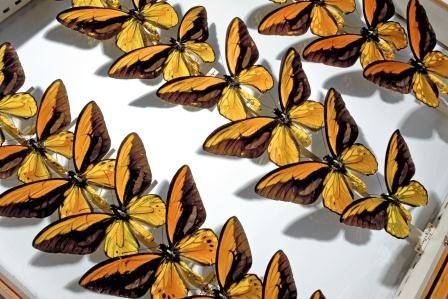Thomas Simonsen has published an invited peer-reviewed paper in Arthropod Structure and Development in collaboration with co-workers from the Finnish Museum of Natural History and Naturalis (Dutch Museum of Natural History) on the continuing importance of morphology in Lepidoptera systematics.
Taxonomy and systematics are areas of science that are focused on description, naming, classification and evolutionary relationships of living things. Such science is the fundamental reason for the existence of large natural history collections, and traditionally the focus has been on morphology - the use of combinations of physical characters such as number of legs, wing patterns or body form. The differences in these characters between species can be compared and allow identification - so a fly will have one pair of wings but a bee will have two pairs, for example. Over time, different species and groups have diverged as a result of evolution and in general become progressively more different in form.
However, while morphology is a key tool in understanding diversity, evolutionary difference can be seen also in molecules, particularly DNA. DNA of different species can be compared and the degree of difference used to assess patterns of evolution and relationships. The use of DNA in taxonomy and systematics is of increasing importance and museum collections are of great value in this new science - a purpose never suspected by those who started to assemble them in the 18th and 19th Centuries.
 Ornithoptera croesus, Wallace's golden birdwing butterfly - a member of the Paplionidae family
Ornithoptera croesus, Wallace's golden birdwing butterfly - a member of the Paplionidae family
Some scientists have argued that DNA alone will be used in future to assess diversity and to identify species: it is after all DNA differences that are the root cause of morphological difference - so why use both? There are in fact a number of reasons why morphological techniques will be of continuing importance - Thomas and colleagues explore the relative value of morphology and molecular information for large groups of butterflies in this paper.
They reviewed the morphological characters that are important for understanding butterfly phylogeny and evolution in the context of large-scale molecular phylogenies (evolutionary classifications) of the group. In particular, they were interested in what the molecular evidence was able to tell them about the evolution of morphological features - so for example, were characters that are used to separate distantly related groups actually caused by large genetic differences?
They looked in particular at the families Papilionidae, Nymphalidae and Hesperiidae which have all been studied with a combination of morphological and molecular data in recent years. What they found was that a scientifically more valuable classification emerged not from using either molecular or morphological techniques, but from using both in combination. They argue that morphology still has an immensely important role to play in butterfly (and insect) phylogenetics - including its value in understanding how the whole organism is important in evolutionary changes, natural selection and diversity.
Simonsen, T. J., de Jong, R., Heikkilä, M. & Kaila, L. (2012). Butterfly morphology in a molecular age – does it still matter in butterfly systematics? Arthropod Structure and Development. 41: pp. 307-322.


